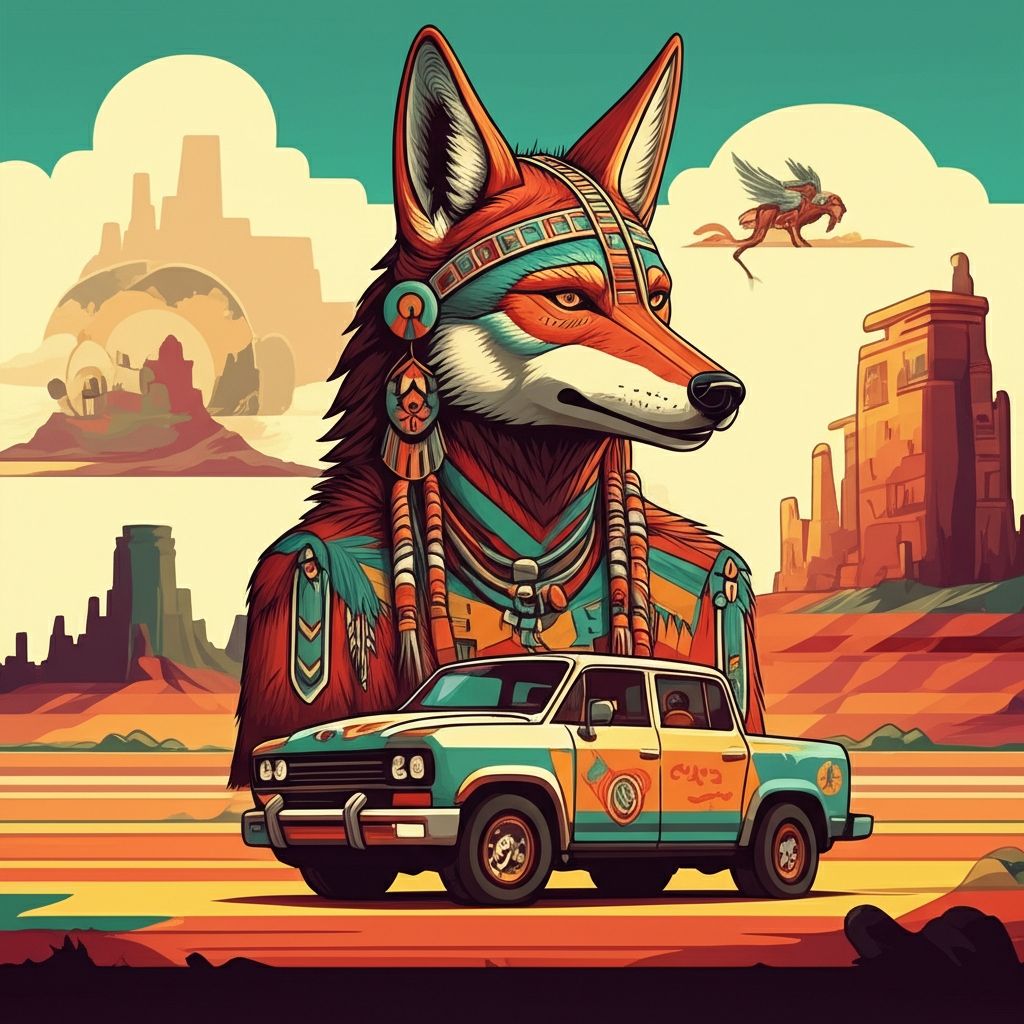
The winds that sweep across the vast, sun-baked landscapes of the American Southwest carry more than just dust and the scent of juniper. They carry whispers, echoes of ancient stories told around crackling fires, tales woven from the fabric of human experience and the mysteries of the natural world. Among these enduring narratives are those that speak of transformative beings, shapeshifters, and the profound connection between humanity and the unseen forces that shaped their understanding of existence. This article delves into one such confluence of mythological threads, exploring the shadowy figure of the Skinwalker, a concept deeply rooted in Navajo tradition, and its thematic resonance with the stark beauty and spiritual significance of the Pueblo Mesa.
Origins and Cultural Tapestry: A World of Interconnectedness
To understand these stories, we must journey back in time, to an era when the Navajo and Pueblo peoples lived in close proximity, their lives intrinsically linked to the rhythms of the desert. This was a world where the boundaries between the physical and spiritual realms were porous, where every rock, every animal, every gust of wind held potential meaning. Survival depended on an intimate knowledge of the land, a deep respect for its power, and a keen awareness of the delicate balance of nature.
The Navajo, known for their nomadic traditions and their profound spiritual connection to the earth, developed a complex cosmology that explained the origins of the universe, the beings that inhabited it, and the moral codes that guided their lives. Their stories often served as cautionary tales, as explanations for natural phenomena, and as moral compasses, guiding individuals towards harmony with the world around them.
Similarly, the Pueblo peoples, who built their remarkable cliff dwellings and agricultural societies in the region, also possessed rich oral traditions. Their worldview was one of interconnectedness, where human beings were part of a larger cosmic dance, influenced by ancestral spirits, celestial bodies, and the very essence of the earth. The mesas, rising like ancient sentinels from the desert floor, were not merely geological formations but sacred spaces, imbued with the presence of the divine and the wisdom of ages.
In this context, stories of transformative beings like the Skinwalker emerged, reflecting a deep-seated understanding of the duality of existence – the potential for both good and evil, for creation and destruction, that resided within both the natural world and the human heart.
The Shadow Weaver: The Skinwalker
The figure of the Skinwalker, or yee naaldlooshii in the Navajo language, is one of the most potent and feared figures in their folklore. It is crucial to understand that this is not a being to be worshipped or emulated, but a representation of profound darkness and transgression within their cultural framework.
Symbolically, the Skinwalker embodies the perversion of sacred knowledge and the violation of natural laws. It is often described as a human being who has acquired malevolent power through dark rituals, often involving the desecration of sacred sites or the sacrifice of animals or even humans. This power allows them to shap into various animals – coyotes, wolves, owls, or even birds of prey – moving with unnatural speed and agility. Their presence is often heralded by chilling sounds, unnatural lights, and an overwhelming sense of dread.
The symbolic attributes of the Skinwalker are not to be interpreted as literal powers. Instead, they represent the potential for individuals to succumb to greed, malice, and a desire to wield power for selfish and destructive purposes. The act of shapeshifting symbolizes the loss of one’s true self, the corruption of one’s essence. The association with nocturnal animals and darkness signifies the hidden, the clandestine, and the malevolent forces that can operate outside the realm of conscious understanding.
The Mesa’s Vigil: A Narrative of Transformation and Fear
Imagine standing on the edge of a vast Pueblo mesa, the sun beginning its descent, painting the sky in hues of orange and purple. The silence is profound, broken only by the whisper of the wind through the ancient stones. It is in such a setting, steeped in the palpable presence of history and nature, that tales of the Skinwalker might have been shared.
The narrative might begin with a tale of a Navajo healer, a respected hataałii, who was known for his deep understanding of the natural world and his ability to mend the sick. However, whispers began to circulate. Some said he had grown too ambitious, too eager for power beyond his allotted responsibilities. He had delved into forbidden practices, seeking to understand the secrets of life and death from a place of selfish desire, not wisdom.
The story would then describe his descent into darkness. His eyes, once filled with compassion, began to gleam with an unnatural light. His voice, once melodic, would become raspy and guttural. He would disappear for days, returning with a strange scent of decay clinging to him. The animals of the land, once his companions, would flee in terror at his approach.
One evening, as the moon cast long, distorted shadows across the desert floor, a hunter returning to his encampment heard a series of unearthly howls, unlike any he had ever heard. They seemed to emanate from the very rocks of the mesa. He looked up and saw a shadowy figure, impossibly tall and gaunt, darting between the ancient dwellings, its movements too fluid, too swift for a human. It was said to have the eyes of a wolf and the swiftness of a coyote, its form shifting and contorting in the moonlight.
The hunter, paralyzed by fear, knew instinctively that this was no ordinary creature. This was a being that had crossed a sacred boundary, a human who had embraced the dark arts, becoming a Skinwalker. The tale would then often focus on the vigilance of the community, the elders who understood the signs and warned the young to stay close to the fire, to respect the ancient ways, and to never stray from the path of balance. The mesa, in these stories, becomes a silent witness to these transformations, its ancient stones holding the echoes of both human folly and the enduring power of the spiritual world.
Symbolism: The Mirrors of the Desert
These narratives, though rooted in fear, held profound symbolic meaning for the people who shared them. The Skinwalker, in its terrifying guise, served as a potent symbol of the dangers of unchecked ambition, the corrupting influence of greed, and the catastrophic consequences of violating the natural and spiritual order.
The act of shapeshifting was a stark metaphor for the loss of one’s true identity, the erosion of one’s moral compass. It represented the potential for humans to become monstrous, to shed their humanity and embrace a predatory existence. The association with animals, particularly those that were nocturnal or feared, highlighted the primal fears that resided within the human psyche and the ways in which these fears could be exploited or manifested.
The Pueblo Mesa, in this context, could be seen as a symbol of stability, of enduring wisdom, and of the connection to the ancestral past. The contrast between the solid, ancient mesa and the ephemeral, terrifying figure of the Skinwalker emphasized the importance of rootedness, of tradition, and of maintaining a harmonious relationship with the spiritual and natural world. These stories were a way of understanding the inherent duality of existence, the constant struggle between light and shadow, creation and destruction, and the responsibility of each individual to choose the path of balance.
Modern Echoes: From Folklore to Fiction
In contemporary times, the figure of the Skinwalker has transcended its original cultural context, appearing in various forms of modern media. It has been explored in literature, television shows, and films, often adapted and reinterpreted to tap into broader themes of horror, mystery, and the supernatural. While these interpretations can sometimes sensationalize or distort the original cultural context, they also serve as a testament to the enduring power of these ancient myths to capture the imagination.
In cultural studies, the Skinwalker serves as a fascinating subject for understanding indigenous belief systems, the psychological underpinnings of fear, and the complex relationship between humans and the natural world. Scholars examine these stories not as literal accounts, but as rich tapestries of cultural meaning, reflecting the values, anxieties, and spiritual understandings of the people who created them.
Conclusion: A Legacy of Storytelling
The narratives of the Skinwalker and the ancient spirits that may have whispered from the Pueblo mesas are a testament to the enduring power of human imagination and the rich cultural heritage of indigenous peoples. These are not tales to be believed as literal truths, but rather as profound expressions of ancient worldviews, explorations of morality, and reflections of the deep connection between humanity and the vast, mysterious universe.
As Muslims, we recognize that the ultimate Creator and Sustainer of all existence is Allah (SWT). These traditional stories, while holding cultural and historical significance, do not alter our understanding of Tawhid, the absolute oneness of God.
However, by studying these myths and legends, we gain a deeper appreciation for the diversity of human thought, the ways in which different cultures have sought to understand their place in the cosmos, and the timeless human need to tell stories. The echoes of Sedna from the frozen north, the shadows of the Skinwalker in the desert southwest, and the silent sentinels of the Pueblo mesas all contribute to the rich tapestry of human heritage, reminding us of the power of imagination and the enduring legacy of storytelling traditions that have shaped our world.





